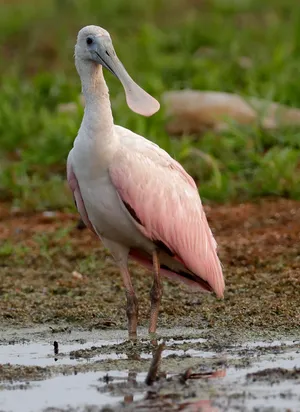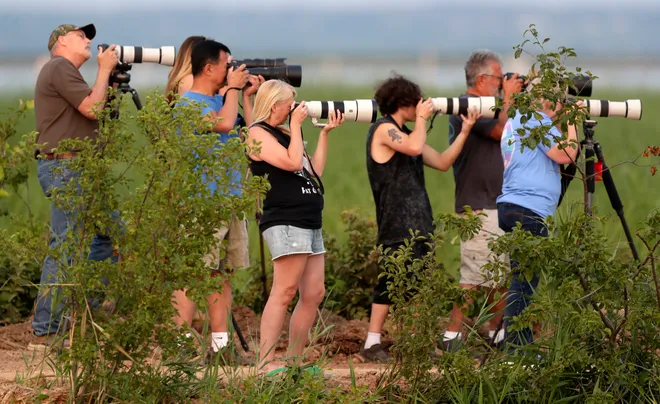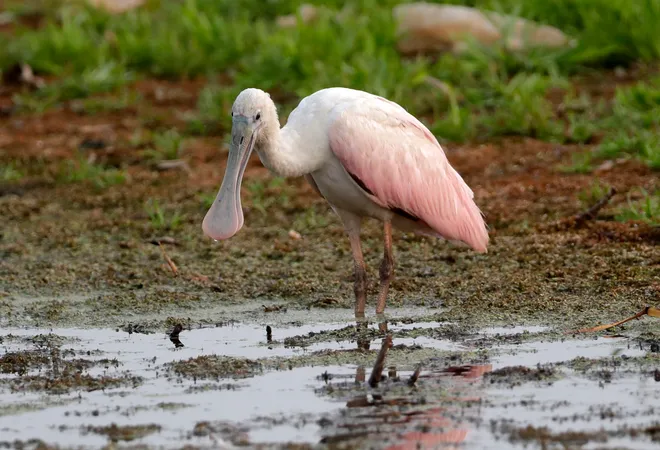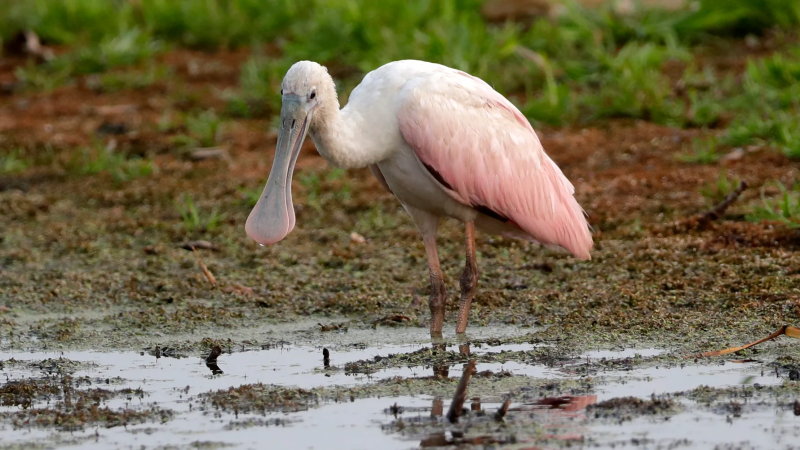This bird hadn't been seen in Wisconsin for 178 years. That changed last week.
GREEN BAY, Wis. – Wisconsin bird watchers have flocked to a Green Bay nature area for a gander at a bird not seen in Wisconsin for almost 180 years.
A roseate spoonbill (pronounced "ro-see-ate") arrived on the shores of Green Bay on July 26 and continues to draw Wisconsin bird watchers and curious onlookers almost a week later.
The bird's light pink feathers and flattened, spoon-shaped bill help it stand out among the egrets and other shoreline birds that populate the Cat Island restoration area and Ken Euers Nature Area, on Green Bay's northwest side.
Roseate spoonbills are a shoreline bird that sweeps their uniquely shaped bills through fresh- or saltwater to feed on crustaceans or fish. They are one of six spoonbill species in the world and the only one found in the Americas, according to All About Birds. Juveniles tend to have lighter pink plumage that turns a much more striking color of pink as they age.
While common in parts of Florida, Texas, Central America and South America, Wisconsin birdwatchers say this is the first time a living roseate spoonbill has been spotted in Wisconsin.
Ever.
Observations indicate a dead roseate spoonbill was spotted in Rock County in 1845 — 178 years ago.
Photos of roseate spoonbills:Roseate spoonbills are already feeling the effects of climate change, experts say

'I've been on cloud nine for days now'
Green Bay-area resident Logan Lasee first spotted the roseate spoonbill Wednesday morning while working a volunteer shift monitoring endangered piping plovers in the Cat Island restoration area. He drove past another piping plover monitoring area, saw the pink plumage and knew he'd spotted something unique.
He called others, including U.S. Fish and Wildlife biologist Jade Arneson and his fellow bird watcher Tom Prestby, to confirm what he saw. In between following the spoonbill and poring through records, Lasee said it became clear he landed his first "mega-rarity," in his time as a bird watcher.
"I've been on cloud nine for days now," Lasee said. "I check almost every day now to see if it's still around. I've had people who knew I'm the guy who found it come up to me. I felt kind of like a celebrity the last few days."
The roseate spoonbill flew away as storms approached Wednesday morning. Lasee, Prestby and others said the bird did not reappear on Thursday or Friday, leading them to worry it had already moved on. But early Saturday morning, another person spotted it in Ken Euers Nature Area and word quickly spread through the tight-knit birding community.
Lasee estimates 100 to 150 people visited the nature area on Saturday to get a look at the roseate spoonbill, including visitors from Eau Claire, Madison, Milwaukee and Appleton.
Prestby became the third person to see the roseate spoonbill last week and said it was his 300th species seen in Brown County and an instant addition to his top five rare birds.
"To have it be such an incredibly charismatic and really wild species was a stunner," Prestby said.

How did the roseate spoonbill end up Green Bay?
The roseate spoonbill isn't endangered or rare, but the bay of Green Bay is quite far away from its normal habitat.
No one knows for sure what happened, but birds do fly off course or get blown off-track by a storm, especially juveniles like Green Bay's spoonbill. Jim Edlhuber, a bird watcher based west of Waukesha, said recent sightings in neighboring states like Minnesota raised his hopes he might see one in Wisconsin.
Edlhuber got the text about the rare sighting and immediately canceled his plans to help friends move into a house. His wife, Deb, packed him a quick lunch and he was en route to Green Bay in minutes. It didn't take long for him to spot it, his 374th bird in 12 years of bird watching.
"It's a huge event in Wisconsin. Huge," said Edlhuber, who shared his experience on his website Window to Wildlife.
More on the birds:Roseate spoonbills feeling the effects of rising seas and warming climate
What is the Ken Euers Nature Area and where is it in Green Bay?
The Ken Euers Nature Area is located at 1701 N. Military Ave., north of Interstate 43 near where it intersects with Interstate 41. The 116-acre area is part of the Green Bay Parks system.
The nature area has seen extensive restoration efforts since 2017 when the city, UW-Green Bay, the Wisconsin Department of Natural Resources and several conservation groups began to clear out invasive species in the area. Since then, the project has restored coastal wetlands and marsh areas, improved public access to the nature area and enhanced fish and wildlife habitat.
"This very project is one of the things making Ken Euers (Nature Area) into better habitat which results in birds like this finding a spot like this," Prestby said. "Restoration can lead to really cool stuff showing up at a place like this."
Extinction:Endangered North Atlantic right whales are in 'crisis'; species approaching extinction
Is there a best time to try to spot the roseate spoonbill?
No matter when you go, bird watchers stressed there is no guarantee you'll spot the roseate spoonbill. There also is no guarantee of how long it will stick around in Green Bay.
With that said, Prestby said the best times to spot the roseate spoonbill are the early morning and evening hours when the sun is rising or setting. The bird might still be visible at mid-day, but might be less active since it is the warmest part of the day. He also said very bright sunlight can make it harder to spot some birds.

Birding in National Parks:America's 10 best national parks for birding and an interactive map for summer bird-watching
Birdwatchers suggest binoculars and offer tips
You don't have to be a hardcore bird watcher to go check out the roseate spoonbill, but experienced bird watchers did share a few tips that will help make your experience more enjoyable.
The roseate spoonbill often hangs out about 100 to 150 yards away from where observers gather so binoculars will be very helpful for a good look at the bird. If you want a picture, a smartphone camera might work, but bring a camera with a longer lens if you want to be sure.
Do not expect to be able to walk right up to the roseate spoonbill. Lasee and Prestby urged everyone to respect the spoonbill and the other wildlife in the nature area by giving them space. If you approach too close, birds will let you know by staring at you, shaking their heads or flying away. And that can ruin the experience for everyone.
"It's a huge privilege for us to see an awesome bird like this in Wisconsin. We don't want to put the bird in jeopardy," Prestby said. "We want others to see it."
Prestby noted the Ken Euers Nature Area is undergoing habitat restoration work right now so there are heavy construction vehicles entering and exiting the nature area. He asked visitors to keep their distance from construction equipment and avoid blocking paths.
Lasee, a member of the Bay Area Bird Club, said bird watchers will likely happily share their binoculars or spotting scope and are likely eager to answer any questions novices might have. He said learning from other birders is how many bird watchers got their start.
"It’s so cool, the birding community, how welcoming it is to everyone, how much fun it is to be a part of," Lasee said.

Contact Jeff Bollier at (920) 431-8387 orjbollier@gannett.com. Follow him on Twitter at @JeffBollier.
Disclaimer: The copyright of this article belongs to the original author. Reposting this article is solely for the purpose of information dissemination and does not constitute any investment advice. If there is any infringement, please contact us immediately. We will make corrections or deletions as necessary. Thank you.





